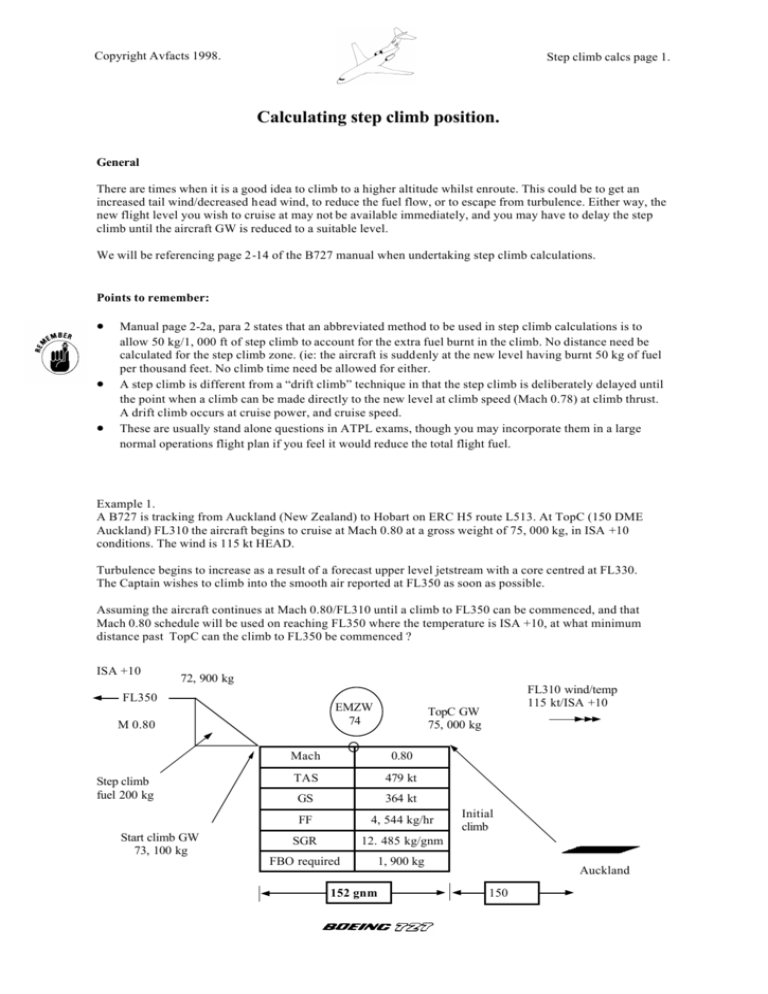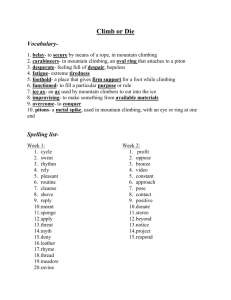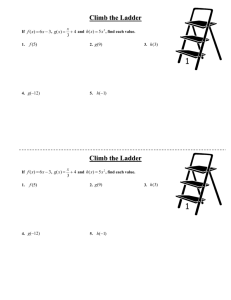Step climbs
advertisement

Copyright Avfacts 1998. Step climb calcs page 1. Calculating step climb position. General There are times when it is a good idea to climb to a higher altitude whilst enroute. This could be to get an increased tail wind/decreased head wind, to reduce the fuel flow, or to escape from turbulence. Either way, the new flight level you wish to cruise at may not be available immediately, and you may have to delay the step climb until the aircraft GW is reduced to a suitable level. We will be referencing page 2-14 of the B727 manual when undertaking step climb calculations. Points to remember: • • • Manual page 2-2a, para 2 states that an abbreviated method to be used in step climb calculations is to allow 50 kg/1, 000 ft of step climb to account for the extra fuel burnt in the climb. No distance need be calculated for the step climb zone. (ie: the aircraft is suddenly at the new level having burnt 50 kg of fuel per thousand feet. No climb time need be allowed for either. A step climb is different from a “drift climb” technique in that the step climb is deliberately delayed until the point when a climb can be made directly to the new level at climb speed (Mach 0.78) at climb thrust. A drift climb occurs at cruise power, and cruise speed. These are usually stand alone questions in ATPL exams, though you may incorporate them in a large normal operations flight plan if you feel it would reduce the total flight fuel. Example 1. A B727 is tracking from Auckland (New Zealand) to Hobart on ERC H5 route L513. At TopC (150 DME Auckland) FL310 the aircraft begins to cruise at Mach 0.80 at a gross weight of 75, 000 kg, in ISA +10 conditions. The wind is 115 kt HEAD. Turbulence begins to increase as a result of a forecast upper level jetstream with a core centred at FL330. The Captain wishes to climb into the smooth air reported at FL350 as soon as possible. Assuming the aircraft continues at Mach 0.80/FL310 until a climb to FL350 can be commenced, and that Mach 0.80 schedule will be used on reaching FL350 where the temperature is ISA +10, at what minimum distance past TopC can the climb to FL350 be commenced ? ISA +10 72, 900 kg FL350 EMZW 74 M 0.80 Step climb fuel 200 kg Start climb GW 73, 100 kg TopC GW 75, 000 kg Mach 0.80 TAS 479 kt GS 364 kt FF 4, 544 kg/hr SGR 12. 485 kg/gnm FBO required 1, 900 kg 152 gnm FL310 wind/temp 115 kt/ISA +10 Initial climb Auckland 150 Copyright Avfacts 1998. Step climb calcs page 2. Working: Step 2. Add step climb fuel @ 50 kg/1, 000 ft to get start climb GW. Step 1. Refer page 2-14 to find maximum arrival GW at FL350/Mach 0.80. Flight Level Crz Schedule ISA +10 350 M 0.80 72, 900 kg 72, 900 + 200 kg = Start climb GW of 73, 100 kg. Step 3. Subtract start climb GW from current GW to get FBO required. 75, 000 - 73, 100 kg = 1, 900 kg. Step 5. Fill in flight profile to get SGR as normal. Divide FBO required by the SGR to get distance to the start of the step climb. 1, 900 kg 12.845 Step 4. Find EMZW by adding step climb GW and current GW together, then dividing by two. 75, 000 kg + 73, 100 kg 2 = 74, 050 (say 74T) =152 gnm past TopC Answer ! Points to note: • • • • A common mistake is to subtract the step climb fuel from the TopC GW instead of adding it. This will almost definately mean a fail in this case. Be aware of whether it is a head or tail wind. Another way to fail. When finding the TopC GW at the new level, remember to use the ISA deviation/Mach number combination at the new level. If you are asked to step climb as soon as possible, and no cruise Mach number for the new level is quoted, enter page 2-14 and extract the cruise schedule that has the highest GW. This will reduce the fuel burn off required, and in doing so shorten the distance to the start of climb point. Typically M 0.79 will allow a Example 2. A B727 is tracking from Auckland (New Zealand) to Brisbane on ERC H5 route A464. Position at 1243 UTC is waypoint “ISROB”, which is 200 DME Auckland, on the 279 Auckland omni radial, FL310. Cruise schedule is Mach 0.82 at a gross weight of 72, 000 kg. Wind/temp 270M/70 kt/ISA +15. A “light chop” is being experienced which is delaying the cabin food service. The Captain wishes to climb into the smooth air reported at FL350 as soon as possible. Assuming the aircraft continues at Mach 0.82/FL310 until a climb to FL350 can be commenced, and that Mach 0.82 schedule will be used on reaching FL350 where the temperature is ISA +15, at what minimum distance past “ISROB” can the climb to FL350 be commenced ? Refer to next page for flight profile and working. Copyright Avfacts 1998. FL350 ISA +15 Step climb calcs page 3. 67, 700 kg To Brisbane Mach 0.82 67, 900 kg “ISROB” 72, 000 kg EMZW 70 200 kg Step climb fuel Mach 0.82 TAS 496 kt GS 426 kt FF 4, 653 kg/hr SGR 10.922 kg/gnm FBO required 4, 100 kg Start of step climb FL310 70 kt/ISA +15 Trk 273M/375 gnm Auckland 200 gnm Flight profile Step 2. Add step climb fuel @ 50 kg/1, 000 ft to get start climb GW. Working: Step 1. Refer page 2-14 to find maximum arrival GW at FL350/Mach 0.82. Flight Level Crz Schedule ISA +15 350 M 0.82 67, 700 kg 67, 700 + 200 kg = Start climb GW of 67, 900 kg. Step 3. Subtract start climb GW from current GW to get FBO required. 72, 000 - 67, 900 kg = 4, 100 kg. Step 5. Fill in flight profile to get SGR as normal. Divide FBO required by the SGR to get distance to the start of the step climb. Step 4. Find EMZW by adding step climb GW and current GW together, then dividing by two. 67, 900 kg + 72, 000 kg 2 = 69, 950 (say 70T) 4, 100 kg 10.922 = 375 gnm past “ISROB” Answer ! Point to note: • A good idea would have been to accept a reduced Mach number cruise schedule at FL350 (say M 0.79). This would mean you could have climbed earlier ( approx 46 gnm past TopC). Copyright Avfacts 1998. Step climb calcs page 4. Example 3. A B727 is tracking from Sydney to Auckland (New Zealand) on ERC H5 route L521. Position at 1202 UTC is waypoint “ANULI”, which is 200 DME Sydney, on the 102 Sydney omni radial. Cruise sched: M 0.84/FL330. Current OAT -55C. GW 72, 800 kg. TWC 35 kt. The Captain wishes to climb the aircraft to FL370 as soon as possible to take advantage of a significant increase in TWC at that level. To allow the step climb sooner, the Captain has accepted the lower cruise schedule of M 0.79 at FL370. Assuming the aircraft continues at Mach 0.84/FL330 until a climb to FL370 can be commenced, and that Mach 0.79 schedule will be used on reaching FL370 where the temperature is ISA, at what time can the climb to FL370 be commenced in the current conditions? 69, 900 kg 1202 UTC “ANULI” 35 kt/ISA -5 EMZW 71 ISA M 0.79 200 kg FL330 GW 72, 800 kg Sydney 200 gnm Mach 0.84 TAS 483 kt GS 518 kt FF 4, 578 kg/hr SGR 8.838 kg/gnm FBO required 2, 700 kg Start climb 70, 100 kg/1237.3 UTC 35.3 min/305 gnm Flight profile Working: Step 2. Add step climb fuel @ 50 kg/1, 000 ft to get start climb GW. Step 1. Refer page 2-14 to find maximum arrival GW at FL370/Mach 0.79. Flight Level Crz Schedule ISA 370 M 0.79 69, 900 kg 69, 900 + 200 kg = Start climb GW of 70, 100 kg. Step 3. Subtract start climb GW from current GW to get FBO required. Step 5. Fill in flight profile to get SGR as normal. Step 6. Divide FBO required by the SGR to get distance to the start of the step climb. 2, 700 kg 8.838 = 305 gnm past “ANULI” Answer ! 72, 800 - 70, 100 kg = 2, 700 kg. Step 4. Find EMZW by adding step climb GW and current GW together, then dividing by two. 70, 100 kg + 72, 800 kg 2 = 71, 450 (say 71T) Step 7. With GS of 518 kt, ETA at step climb is 1237.3 UTC. Now try the step climb assignments.




